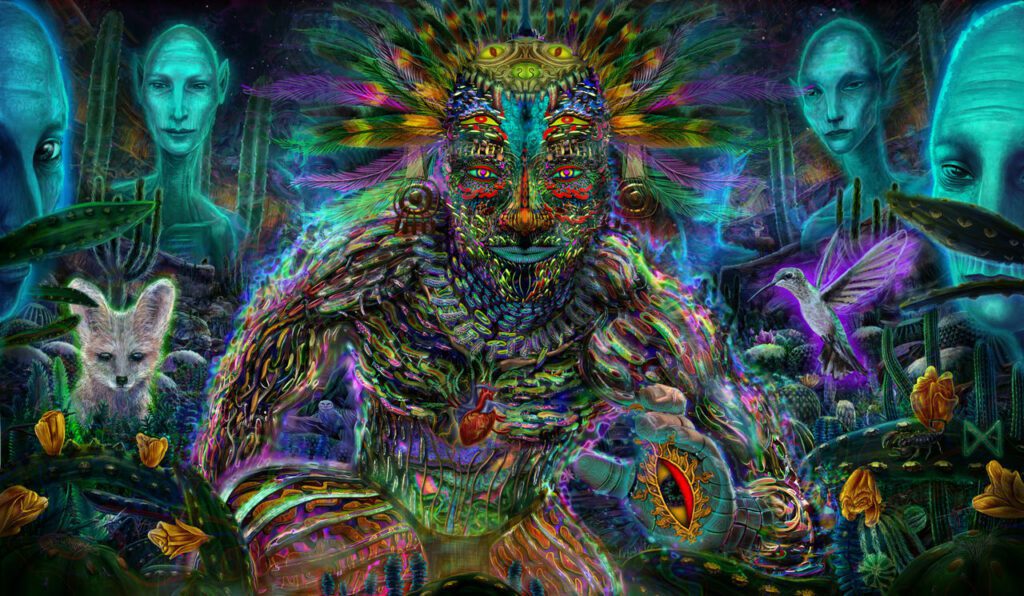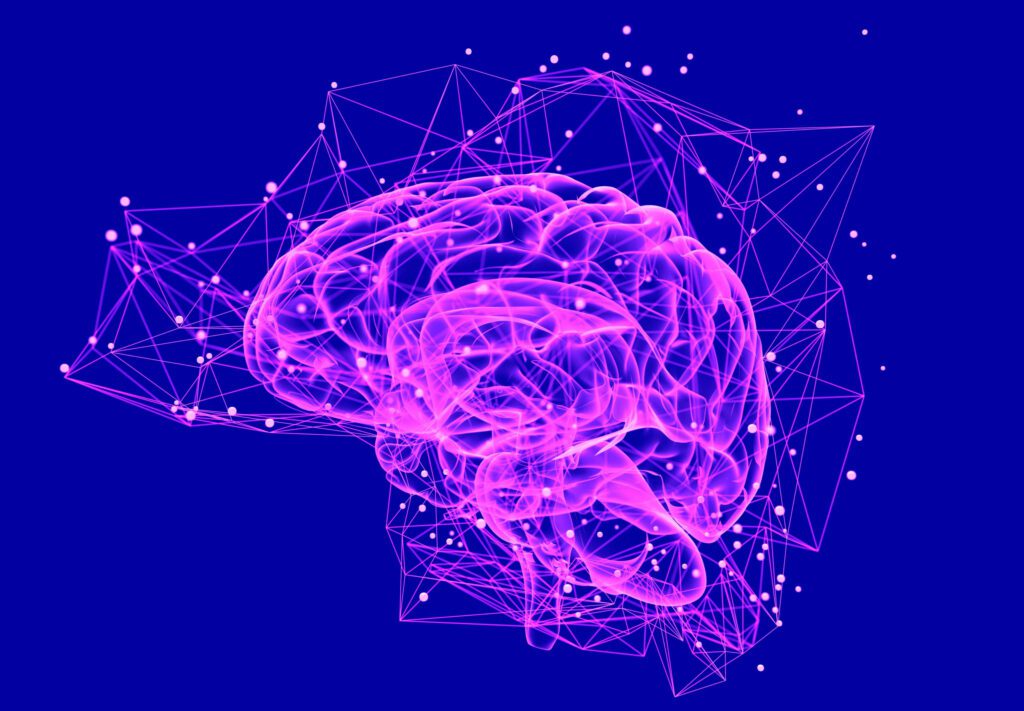Kevin Thorbahn abruptly found himself in a hotel lobby, awash with a dazzling kaleidoscope of light and intricate geometric shapes. It was as if he had been thrust through the glass window of an immense stained-glass artwork! He knew nothing except this strange draw to the entity behind the counter: rather than a woman, it seemed more like an outline composed entirely of energy that glowed with beautiful lavender hues.
As he was about to make contact with her, the surreal dreamlike world of N,N-Dimethyltryptamine (DMT) whisked him away into an infinite hallway that led back to reality. Although his journey felt like hours, it had peaked for only six minutes before quickly fading from memory like a forgotten dream upon waking. The hotel lobby and its enigmatic entity were fast disappearing as the powerful effects of DMT were dissipating in his body.
Longing for additional time, Thorbahn was desperate to engage with the graceful purple being and discover each captivating passageway of that kaleidoscopic palace. He wanted to map every remarkable corridor and document alluring details along his journey.
Soon, it could be possible.
Known as the “spirit molecule” in psychedelic communities, N,N-Dimethyltryptamine (DMT) is said to cause distinct and remarkably similar visions for those who use it.
When DMT is ingested, it can open a portal to an alternate reality that’s unparalleled in its vividness and surrealism. Each journey could prove to be unique as people often experience astounding encounters with ultra-real entities that seem conscious and vastly complex. By consuming DMT, we are presented with the opportunity for profound insights into the enigma of our world – from consciousness to what lies beyond human knowledge.

In the ’90s, Dr. Rick Strassman made a remarkable discovery that reawakened the swooning psychedelic revolution: DMT, or what he dubbed as “The Spirit Molecule.” This molecule has an incredible ability to change our consciousness and awareness of reality, while also being able to aid us in transitioning through death into some sort of afterlife. With this revolutionary finding came greater insight than ever before on humanity’s relationship with other realms – one which will shape our understanding for generations to come.
A new extended-state version of the powerful drug may now provide psychonauts with longer trips than ever before. These daring explorers are looking to discover and document if individuals can enter a shared alternate reality when they take the substance.
What happens during Psychonauts Training?
Thorbahn is pioneering a novel concept of psychonautic exploration with extended-state DMT. By smoking this drug, its effects linger for minutes even though it may seem like an eternity. However, if the user takes in a continuous supply and regulates their blood serum levels to match the molecule’s concentration then the journey can extend up to hours or days – truly entering another realm where time passes differently than we are used to.
Thorbahn and other psychonauts have the opportunity to bring back detailed trip reports of their experience with this method. The captivating part of a DMT journey is its similarity; various users may see similar landscapes or beings, such as the beloved mechanical elf that keeps appearing in these trips. For Thorbahn, it seemed “more real than real” – something often mentioned within DMT-experimenting circles. What extended-state programs aim for is discovering new parts of our minds or even another dimension – rather than just being extremely high from what they take in.
DMT is steeped in mystery, with research suggesting that our brains produce the psychedelic drug naturally while those who consume it frequently report entering a separate plane or dimension full of “machine elves,” which are thought to be spiritual entities. These creatures allegedly greet travelers and guide them through their journey.
Although this program is still in the early stages of development, Thorbahn is hopeful that he and others will soon have the opportunity to explore realms that have existed beyond our physical world. In the meantime, he will continue to experiment and document his experiences to expand the collective knowledge of this strange alternate realm that may be accessible through DMT.
Thorbahn, an expert in biology and chemistry as well as the owner of an organic soil company in Colorado, was driving home late one night when he heard about DMTx- a program offered by Medicinal Mindfulness. Founded back in 2012 by two psychotherapists based out of Boulder, Medicinal Mindfulness is both a psychedelic therapy clinic and provider of cannabis and ketamine-assisted sessions that have been known to successfully help individuals struggling with trauma, depression, or feelings of meaninglessness.
The clinic’s website strongly states that they “strictly adhere to all local and Colorado State cannabis laws, as well as federal regulations.” In 2016, DMTx was born with the hopes of eventually conducting FDA-approved clinical studies on DMT. But for now, it is continuing its mission without adhering to the stricter constraints imposed by the FDA; this allows them to best serve those within the psychedelic community who are passionate about these topics.
It is time to Delve into the Crucial Enigma: What on earth is happening here?
When Thorbahn heard about the DMTx project, he eagerly submitted several essays and was soon welcomed as one of the initial dozen psychonauts.
In 2016, Andrew Gallimore and Rick Strassman published a paper in Frontiers in Physiology that laid out the foundation of DMTx. The authors mentioned how dream states as well as psychotic episodes have been extensively studied; however, with regards to the unique state of consciousness induced by endogenous human hallucinogen DMT, its phenomenology has only just started being studied. Through their method of intravenous infusion to sustain stable brain concentration levels for an extended period, they sought to explore this phenomenon further.

Dr. Strassman, a renowned clinical research psychiatrist and author of the acclaimed book DMT: The Spirit Molecule, is pioneering this field with his extraordinary studies on psychedelic phenomenology. While many may consider exploring extended trips to be odd, Dr. Strassman insists that these experiments can provide real scientific benefits. Interestingly enough, our brains produce Dimethyltryptamine (DMT) endogenously; however, we have decreased resilience towards it compared to other substances such as Lysergic Acid Diethylamide (LSD).
It remains a mystery as to whether DMT is involved in human physiology. Dr. Strassman seeks answers regarding the possibility of a specific neurotransmitter system, much like serotonin or dopamine, and if an individual’s resistance to DMT may play a factor in mental illnesses such as schizophrenia.
Strassman proposed that an extended-state experience would offer a more leisurely exploration of the DMT effect, and also afford “a more stable and rich dialogue with the beings” experienced by many trippers. He argued that documenting these seemingly supernatural encounters is worthwhile from both scientific and experiential perspectives.
Strassman is aware of how potentially controversial this kind of discussion can be. When he was initially granted funding by the National Institutes of Health in 1990 to explore DMT, his peers were not just doubtful but also apathetic:
“Within the scientific community, at least the larger academic one, my initial results were either barely noticed or referred to in a bemused manner,” he said. “No one told me I was going to kill my career by studying DMT. In fact, no one knew what DMT was.”
Recently, there has been a tremendous surge in psychedelics research. Pioneering teams at Imperial College’s Centre for Psychedelic Research and the University Hospital of Basel are now conducting initial studies on extended-state DMT.
However, the DMTx program isn’t a traditional research facility. David McQueen and his team at the Center for Medicinal Mindfulness initiated this project to explore how therapeutic cannabis and other psychoactive substances can benefit us before they discovered Strassman’s study. As soon as he heard about it, David couldn’t stop talking – everyone wanted to know more. After fielding numerous questions from curious minds, he has since developed answers that are based on speculation but hold the promise of further discoveries in this field.
How Long can a Trip be Sustained Safely?
What if a participant needs to answer nature’s call? McQueen has done the research and found that astronaut diapers are an ideal solution — specially designed adult diapers used for spacewalks.
He estimates that the experience could last up to three hours, but it may extend even longer. If a participant needs to take a break while in an altered state of consciousness, astronaut diapers have been investigated as an option. Moreover, if two participants had their minds connected through extended-state drip and were placed in separate rooms – would they be able to communicate with each other through DMT space? McQueen isn’t sure yet; nevertheless, he is determined to find out – his enthusiasm for this experiment has become contagious.
In November, Colorado citizens voted to authorize the utilization of psychedelic treatment at special healing centers in their state. Presently psilocybin and psilocin mushrooms are their only authorized “natural medicine.” Proposition 122 also allows for ibogaine, mescaline, and DMT usage but has set up a procedure for reclassifying DMT as an approved remedy by 2026. This would permit licensed facilitators to lead patients through its use with confidence.
David McQueen envisions a unique experiment that could be possible if it gets approval from the US Food and Drug Administration (FDA). His goal is to see if two people receiving intravenous infusions in separate rooms can communicate inside their individual trips. To ensure safety protocols are being followed, every step of this experiment will be supervised by medical professionals.
Dr. Michael Champeau, president of the American Society of Anesthesiologists, mentioned that a multi-hour intravenous infusion is not uncommon—particularly with fast-acting drugs—and can be performed safely under professional supervision to monitor vital signs. Pharmacokinetically speaking, Dr. Champeau noted that this method makes sense for DMTx’s plan as the drug’s effects are short-lived.
However, he warned that the potential risks of an intravenous DMT drip are unknown. The greatest worry isn’t physical but mental – hallucinogens have been known to cause or worsen certain psychological conditions in some cases like psychosis in rare instances. Needless to say, the organizers of DMTx do not suggest experimenting with this at home.
So what exactly are the Pioneering “Psychonauts” Doing?
Initially, McQueen’s center conducted several face-to-face training sessions in Boulder. The participants learned to induce DMT–like states and then created trip reports under cannabis influence. But since the pandemic hit, all training has been done online with a dozen or so students from different backgrounds. The center is striving to create a protocol for its initial DMT trial runs soon.
McQueen is still debating whether a psychonaut experience is merely in one’s head or something else. He wants to bring together both artists and spiritual leaders along with scientists from different fields, hoping that this will provide answers for the world’s problems which can be both feasible and incredible at the same time. According to McQueen, “The goal of this would be like an advanced creative problem-solving tool for technological advancement.” Albert Einstein once said “We cannot solve our problems with the same thinking we used when we created them,” a statement which resonates strongly with McQueen himself.
With the regulatory framework for legal and guided DMT trips in Colorado still pending, McQueen is looking towards Jamaica as the ideal location to launch their first extended excursions. There, between the Caribbean tourists and pockets of cruise ship meal tickets, his group will have a chance to explore the rich depths of inner consciousness through this profound experience.
John Lawrentz is a passionate psychonaut who practices psychedelic therapy, which he defines as an internal form of self-healing. He believes that it differs from traditional talk therapy because the healing happens independently within oneself rather than relying so heavily on external influence. Currently, John works with cannabis but has also experimented with DMT and remarks on the immense amount of individual problem-solving achieved during its effects.
The Future of Psychedelic Drugs in Therapeutic Treatment
An overwhelming body of research is confirming the notion that psychedelic-assisted therapy can be extremely beneficial to managing mental health issues, such as depression, anxiety, and PTSD. It’s no wonder pharmaceutical companies are taking notice; experts predict the global market for psychedelic drugs will hit $6 billion in just six years. Substantial revenue from psychedelics is likely to originate primarily from treating depression, with major pharmaceutical companies already creating pills of ayahuasca and DMT injections.
Through an expansive underground network in the US and Europe, ayahuasca brew is served and overseen by non-indigenous South American guides. This remarkable ceremony takes place not only in remote jungles but also within suburban homes and city flats throughout the continent with buckets at hand in case of any unexpected occurrences.
While some may find it upsetting that large pharmaceutical corporations are profiting from experiences traditionally considered spiritual, the commodification of psychedelics is nothing new. Ayahuasca, a combination made up of DMT and inhibiting plants that enable humans to make use of its molecule, has been used for thousands of years in various religious rituals, healing ceremonies, and social gatherings throughout South America.
Critics have highlighted the potential losses of discarding or disregarding the cultural and religious elements that are embedded in traditional ayahuasca ceremonies and participating as an outsider. Yet, it is evident that those who create DMTx take a spiritual approach to this drug seriously – they’re not aiming at replicating Amazonian rituals but rather adopting a progressive attitude towards religiosity seen in establishments such as the Center for Medicinal Mindfulness.
Exploring the Transformation of Psychedelics
Since the dawn of psychedelics, finding the right words to accurately portray indescribable experiences has been a problematic feat. Timothy Leary – infamous LSD researcher and advocate – proposed in 1966 an ‘experiential typewriter’ to better describe trips. At DMTx, organizers are always looking for new ways to explain the psychedelic journeys that they take part in. They have even employed a police sketch artist as part of their program. When selecting potential psychonauts, a crucial factor is how well applicants can articulate what they’ve experienced.
During his DMT experiences, Lawrentz encounters entities that many others have experienced as well–intelligent, otherworldly beings. He has come to understand that these are probably parts of himself. He noted that it’s difficult to explain in words, but it feels like when you’re alone and then somehow not alone at the same time–as if there is a close friend who is there for you without having to say or do anything else except be present with them.
He’s experienced an immense amount of love in the DMT realm, something so powerful it almost seemed supernatural. Like many others, he desires to remain longer and discover what more this space can teach him – even if these entities and worlds are only existing within his own mindscape.
If this finding holds to be true, it would ultimately rewrite what we understand about reality and consciousness. In fact, if such a discovery were made, the results could arguably be life-altering! We can only imagine how trippy that experience might truly become. As the boundaries of exploration continue to grow, the untapped potential of psychonauts is eagerly anticipated. Who knows what mysteries await them in the future? The insights gained from their explorations will certainly enable us to gain a deeper understanding of ourselves and our world. Who knows what we’ll discover? The possibilities are truly exciting.
The potential of these explorations is already transforming how we view psychedelics. As Lawrentz puts it: “Psychedelics can open up new pathways to understanding, and help people have experiences that can be deeply healing and truly transformative. If we’re open to it, these medicines can help us explore the depths of our innermost selves, and find answers to our life’s biggest questions.”
It’s clear that the psychonauts of DMTx are determined to make those answers known. And with the right guidance, their inner explorations could be a breakthrough for us all. Join them in this incredible journey to discover new dimensions of our reality. The possibilities are truly endless! What will they find? Only time can tell.
Are you interested in becoming part of the DMTx psychonaut training program? For more information, please visit www.dmtx.org.
